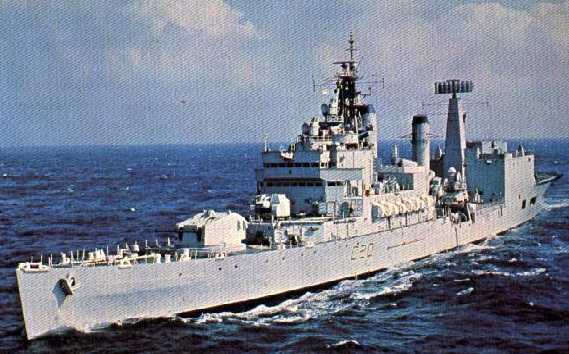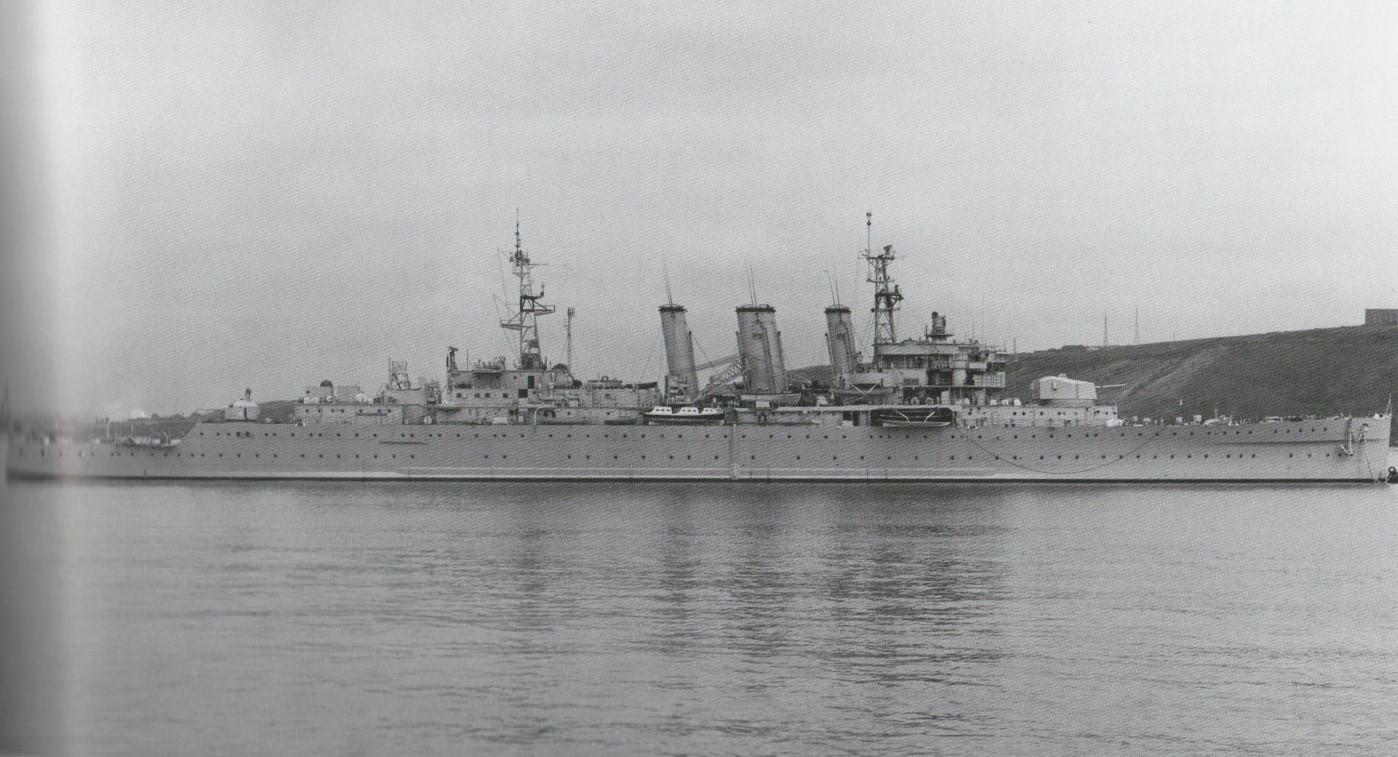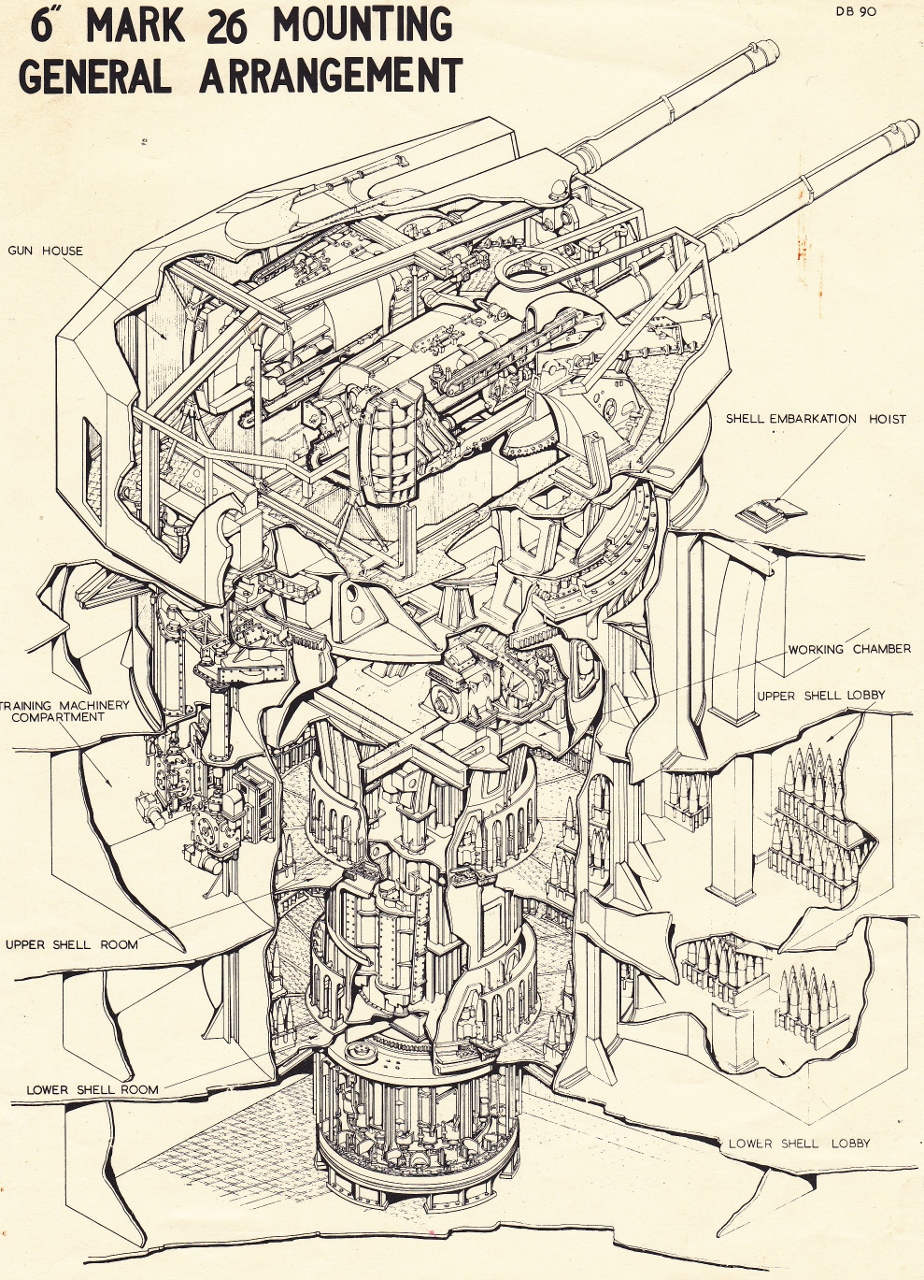
This was an automatic gun of "all-steel" construction with a high rate of fire and was the first British 6" (15.2 cm) design to use cartridges instead of bagged powder charges in over sixty years. These weapons were originally intended for triple mountings on the projected Neptune class of 1945 and for twin mountings on the projected Minotaur class of 1947. These projects were both canceled shortly after the end of World War II and the first two experimental guns were not completed until 1949. Per the post-war naval gun designation system, they were then redesignated from QF Mark V to QF Mark N5.
In the early 1950s, these weapons were selected to arm the Tiger class cruisers, which had lain incomplete since the end of World War II. These ships were then completely redesigned and work was resumed in 1954 with HMS Tiger being completed in 1959, nearly two decades after she had first been laid down.
There are many reports that these weapons were unreliable in service, but that does not seem to have always been the case. The initial problems found during development at Shoeburyness and with the prototype on HMS Cumberland were rectified during trials, one major breakthrough being the choice and filtration of the oil in the oily servos fitted to the turrets.
"A normal days' firing would be 150 to 200 shells every day. Lion would be engaged in doing a shoot, usually at both air and surface targets. The problem with the turrets was not reliability, but with the inordinate amount of highly skilled technical staff required to keep the guns operational (ordnance artificers, weapons mechanics and seaman armourers). That said, on Lion the maintenance team on A turret used to muster at 1330 on Q1 gundeck with umbrellas, before disappearing into the dripping oily wastes of A turret. We had two misfires that I remember, the shell eventually falling out into the sea after about 20 minutes. Lion at least twice changed all its barrels (the last time from Hong Kong when an emergency flared up and only one gun was operational the other three barrels were changed at sea on the way). The joke round the fleet never was reliability, the joke always was that the ships could fire all ammo off within 20 minutes. Of course, this was never true as you would only fire so many seconds and then change targets. In normal practice shoots against AA targets, the first shell would hit the target. On NGS shoots, two or three targeting rounds would be fired to hit the target and then a twenty second burst with both barrels would destroy the target." - Peter Parkinson, who served on HMS Lion during her second commission.
"The mounting was controlled by 118 manually operated switches, 141 push buttons, 11 contactors, 43 actuators, 79 relays and 244 microswitches. Tiger's gun was electrically elevated and trained (unlike Blake's which was hydraulic)." - Darrel Williams, who served aboard HMS Tiger.
In contrast, Peter Marland states: "The 6in Mk26 was a disaster: a large complex turret weighing 152 tons that rarely achieved the gun functioning burst-fire requirements." He blames this on the high torques in the feed system, "particular problems were the scuttles and tilting buckets, the three-part feed tray, and complexity caused by a Recoil Energy Power System (REPS) used on the elevating mass of the gun. Mr. Marland further states ". . . the 6in weapon rarely achieved its designed rate of fire of 20 rounds per minute per gun due to mechanical failures in its highly stressed feed system. Initial firings were successful, but by later life the 6in system had become an embarrassment."
These weapons were controlled by the Gun Direction System (GDS1) using the Type 992 radar. This system enabled the ships to engage multiple targets within a few seconds of each other and was technically very advanced for its time.
HMS Blake was the last cruiser in commission in the Royal Navy. In December 1979, a few days before she was decommissioned, she enjoyed the distinction of firing the Royal Navy's last 6" (15.2 cm) gun salvo.
Constructed of a loose barrel and jacket with annular cooling space between them. Used an hydraulically operated horizontal sliding breech block.
Unless otherwise noted, the data below is for the guns and mountings used on the Tiger Class.
| Designation | 6"/50 (15.2 cm) QF Mark V
6"/50 (15.2 cm) QF Mark N5 |
|---|---|
| Ship Class Used On | Tiger Class
Prototype on Cumberland |
| Date Of Design | 1944 (suspended, resumed in 1948) |
| Date In Service | 1959 |
| Gun Weight | 15,344 lbs. (6,960 kg) |
| Gun Length oa | 315 in (8.001 m) |
| Bore Length | 300 in (7.620 m) |
| Rifling Length | 255.4 in (6.486 m) |
| Grooves | 36 |
| Lands | N/A |
| Twist | N/A |
| Chamber Volume | N/A |
| Rate Of Fire | 15 - 20 rounds per minute 1 2 |
- ^Firing at the maximum rate of 20 rounds per minute often caused jamming. Reducing the firing rate to 15 or 17 rounds per minute increased reliable operation.
- ^Quotes from "The Turret Captain on HMS Tiger" provided by Darrell Williams:
"The weight of the rotating structure is 171 tons; each gun weighing 7 tons. The mounting can train at 40 degrees per second, a speed it achieves from standstill in less than 2 seconds."
"Firing at 17 rounds per minute per gun, it can discharge the following every 60 seconds: 2 tons of shells, 1/2 ton of cordite and 13 cwt of brass (as spent cases onto the gundeck). When these cases strike the deck they remove 100 inches2 of green paintwork (which does not please the foc'sle PO)."
"Each shell travels at 1,656 mph and at the point it leaves the barrel is spinning at 1,096 rpm. If the guns fired continuously for 26.5 minutes (which is impossible given how unreliable they are) they would discharge all the ammunition onboard; i.e., 50 tons of shells and 38 tons of cartridges."
"When full, the hoists hold 2.5 tons of ammunition."
- Although the barrels were provided with water jackets, continuous firing caused the muzzles to become very hot and manual water spraying had to be used to cool them.
| Type | Separate 1a |
|---|---|
| Projectile Types and Weights | AP - 129.75 lbs. (58.9 kg)
HE - 132.00 lbs. (59.9 kg) |
| Bursting Charge | NA |
| Projectile Length | N/A |
| Propellant Charge | 34.5 lbs. (15.6 kg) SC
Cartridge - 70.0 lbs. (31.8 kg) 2a |
| Muzzle Velocity | 2,520 fps (768 mps) 3a 4a |
| Working Pressure | N/A |
| Approximate Barrel Life | 1,400 rounds |
| Ammunition stowage per gun | 400 rounds |
- ^Ammunition for the cancelled Neptune class was also separate.
- ^Cartridge cases were made from steel rather than brass.
- ^The muzzle velocity was originally 2,640 fps (805 mps) but this was reduced to the above figure in order to obtain a more curved trajectory to enhance deck penetration.
- ^The relatively low muzzle velocity gave these guns good accuracy, but they could easily jam should the steel cartridge cases be out of tolerance.
| Elevation | Range |
|---|---|
| 45 degrees | about 25,000 yards (22,860 m) |
| Designation 1b | Three-gun Turrets
Neptune Class (3): Mark XXV 2b Two-gun Turrets
|
|---|---|
| Weight | Mark XXV: 202 - 204 tons (205 to 207 mt)
Mark XXVI: 156 tons (158.5 mt) |
| Elevation | Mark XXV: -5 / +80 degrees
Mark XXVI: -5 / +78.5 degrees (possibly +80 degrees) |
| Elevation Rate | N/A |
| Train | about +150 / -150 degrees |
| Train Rate | 40 degrees per second |
| Gun recoil | N/A |
| Loading Angle | Any |
- ^Only the Modified Mark XXVI (Mark 26) two-gun mountings entered service.
- ^The proposed Mark XXV showed significant improvements over pre-war designs. Drawings for this mounting show each gun in its own cradle with electric training and elevation via hydraulic drive and pinions. Loading was via hydraulic rammers at any angle of elevation. Each gun had a pusher hoist for cartridges and two pusher hoists for shells, one for HA and the other for LA shells. The cartridge hoist fed from a cartridge ring holding 21 cartridges while the shell hoists fed from individual shell rings, one above the other, each holding 72 shells. Expended cartridge cases were ejected via chutes to flap-covered ports in the gunhouse face. This project was abandoned with the cancellation of the Neptune class at the end of World War II.
- The turret mounted on HMS Cumberland for trials was afterwards removed and held as a spare. Out of the other six Mark XXVI (Mark 26) turrets used afloat, four used RP15 electro-hydraulic control and were used on HMS Blake and HMS Lion. The other two turrets used RP50 for elevating and RP53 electric control for training and these were used on HMS Tiger.
- The aft mounting was removed on HMS Tiger and HMS Blake in the mid-1960s to allow the installation of helicopter facilities and a missile battery.
- Guns were individually sleeved in all Marks.
- There were hatches in the rear of the gunhouse through which the loose barrels could be withdrawn and replaced.





"Naval Weapons of World War Two" and "British Naval Guns 1880-1945 No 13" article in "Warship Volume VIII" both by John Campbell
"The Postwar Naval Revolution" by Norman Friedman
"Postwar Weapons in the Royal Navy" article in "Warship 2015" by Peter Marland
"The Hybrid Warship" by R.D. Layman and Stephen McLaughlin
"Cruisers of the Royal and Commonwealth Navy" by Douglas Morris
"British Cruisers of World War Two" by Alan Raven and John Roberts
"British Fiji Class Cruisers and their Derivatives: Design, Development and Performance" by Conrad Waters
---
Special help from Peter Parkinson, Zhu Shipeng and Darrel Williams
23 November 2006 - Benchmark
11 February 2012 - Updated to latest template
05 January 2014 - Added photograph of Blake
28 November 2015 - Changed Vickers Photographic Archive links to point at Wayback Archive
27 December 2015 - Added General Arrangement sketch and notes on HMS Tiger mounting
02 September 2016 - Converted to HTML 5 format
04 December 2019 - Reorganized notes
31 July 2023 - Correction photograph caption
09 April 2024 - Changed ammunition type
20 February 2025 - Added photograph of HMS Cumberland
15 March 2025 - Added comments from Peter Marland
